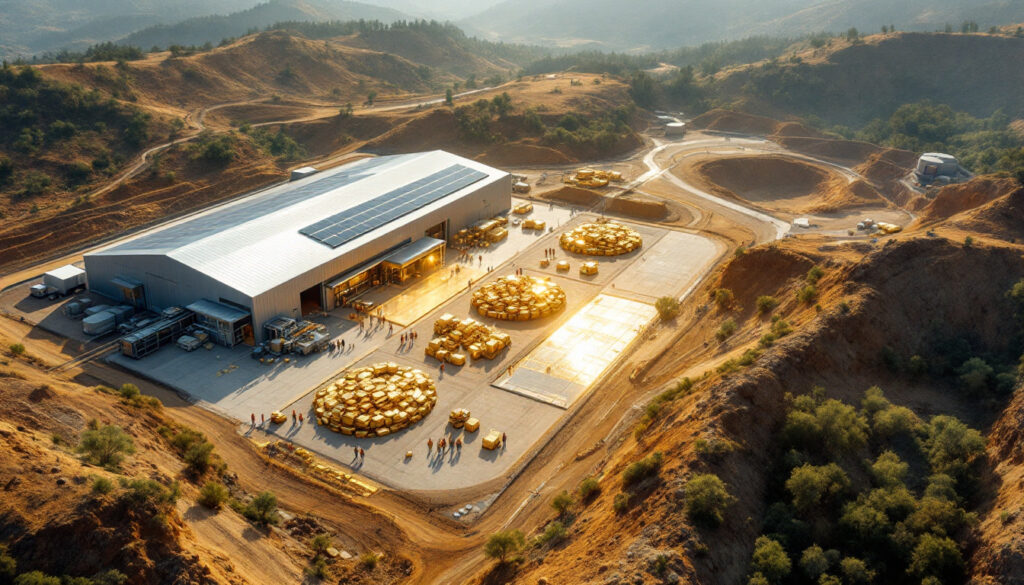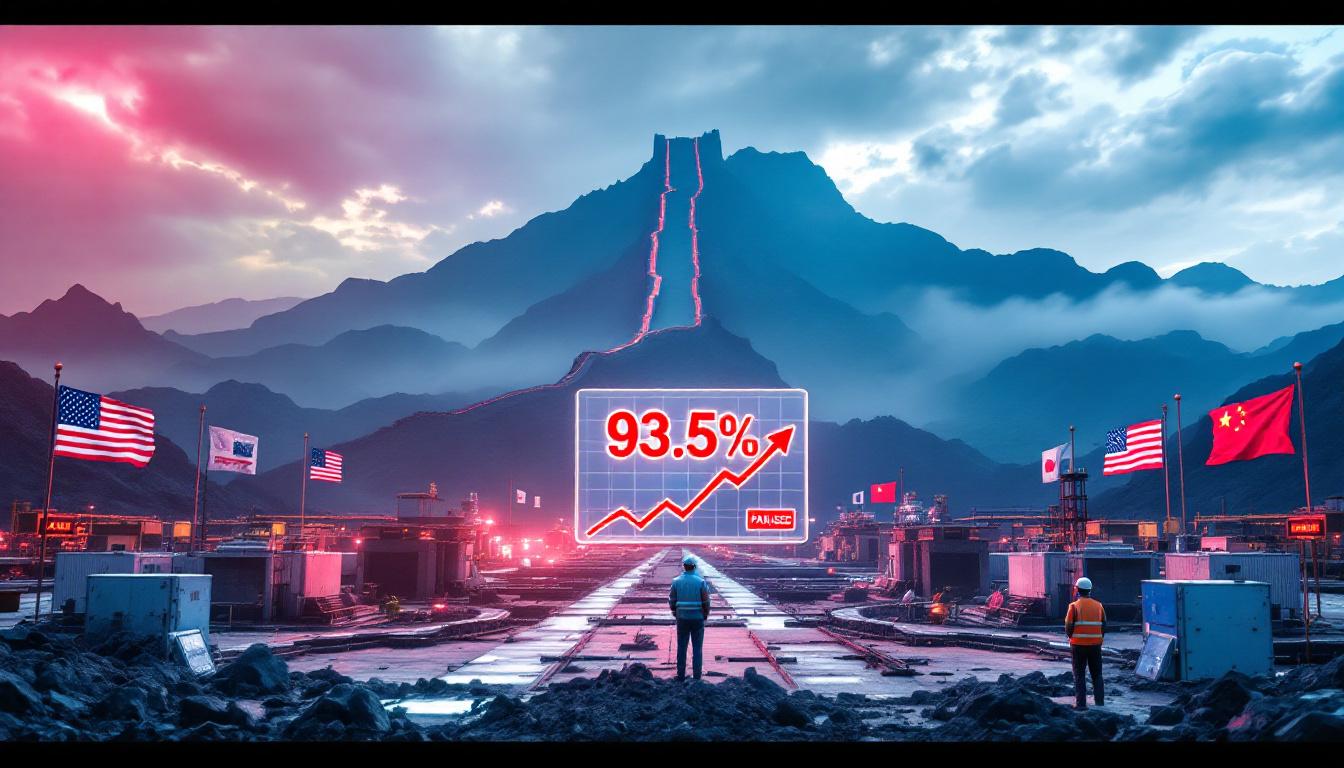What is the SMO ESG Benchmark for Gold Mining?
The SMO ESG Benchmark represents a groundbreaking advancement in responsible gold mining evaluation, offering the first independent, mine-level ESG dataset designed specifically for transparency and accountability. Launched by Single Mine Origin (SMO) Gold in May 2025, this innovative tool brings unprecedented visibility to the sector by providing disaggregated Environmental, Social, and Governance data for individual mining operations rather than the traditionally opaque corporate-level aggregates.
The benchmark's revolutionary approach addresses a critical industry gap by providing granular mine-specific metrics that allow direct comparison of sustainability performance across different gold mining operations. This enables stakeholders to evaluate the true environmental and social impact of individual mines, rather than relying on company-wide averages that often mask underperforming operations.
"Until now, even the most comprehensive corporate sustainability reports have struggled to deliver transparent mine-level ESG data in a standardized, comparable format," explains Charlie Betts, co-founder of SMO Gold. "The SMO ESG Benchmark changes this paradigm by providing the transparency needed to drive meaningful improvement in responsible gold mining practices."
Key Features of the SMO ESG Benchmark
The benchmark's architecture prioritizes both comprehensiveness and practical utility, with several innovative features:
- Mine-specific ESG performance metrics that isolate sustainability data at the operational level
- Comparative analysis capabilities allowing direct performance comparison between similar mining operations worldwide
- Structured environmental data covering carbon emissions, water usage efficiency, and waste management protocols
- Detailed workforce demographics including diversity statistics and female employment levels across operational roles
- Community investment tracking that quantifies social contributions to local economies
- Business ethics assessment measuring transparency, anti-corruption measures, and regulatory compliance
The platform employs an intuitive traffic light scoring system where green indicates performance exceeding industry standards, yellow shows compliance with baseline requirements, and red flags areas requiring immediate attention. This visual framework enables quick identification of both leaders and laggards across the gold mining sector.
Development Partners and Expertise
The benchmark was developed through a strategic collaboration with Virtua Research, a leading ESG data solutions provider with extensive experience in natural resource sectors. Their proprietary data structuring methodologies ensure compatibility with diverse reporting formats used by mining companies globally.
The project has been guided since December 2024 by sustainability expert Kate J. Harcourt (MSc, MIEnvSc, CEnv), whose three decades of experience working with mining companies, lenders, and international organizations has been instrumental in establishing the benchmark's technical rigor.
"What makes this initiative particularly valuable is its focus on operational specificity," notes Harcourt. "By disaggregating ESG data to the mine level, we've created a tool that enables meaningful comparisons between similar operations and provides actionable insights for improvement."
The Betts Group, co-founders of SMO Gold with over 250 years of experience in precious metals, has provided critical industry-specific insights ensuring the benchmark addresses real-world ESG challenges in mining while remaining accessible to diverse stakeholders.
Why is Mine-Level ESG Data Revolutionary for Gold Mining?
The Problem with Corporate-Level ESG Reporting
Traditional ESG reporting in the gold mining sector has been hampered by aggregation at the corporate level, creating significant transparency challenges. When mining companies consolidate sustainability data across multiple operations, the resulting metrics obscure crucial variations between individual mines.
This aggregation creates several problems for stakeholders seeking to evaluate true sustainability performance:
A mining company might report impressive overall carbon reduction figures that actually stem from one high-performing mine while multiple other operations maintain poor environmental practices. Similarly, a single problematic mine with significant community conflicts can be concealed within positive corporate-wide community relations statistics.
For investors conducting due diligence, aggregated data necessitates time-consuming analysis that often fails to uncover specific sustainability risks. Without mine-level transparency, it becomes nearly impossible to identify whether a company's environmental claims derive from exemplary practices at one site or mediocre performance spread across many.
Most concerning is the difficulty in comparing performance between specific mining operations. Two gold mines operating in similar regions might have vastly different water management practices, but this distinction disappears when rolled into corporate-wide metrics.
Benefits of Mine-Specific ESG Benchmarking
The SMO ESG Benchmark fundamentally transforms sustainability evaluation by enabling direct comparison between similar operations. This mine-level perspective reveals performance outliers that would otherwise remain hidden, allowing stakeholders to distinguish between truly responsible operations and those merely benefiting from corporate averaging.
The granular approach provides unprecedented insights into local environmental impacts, particularly critical for water-stressed regions where mine-specific water consumption and recycling rates matter significantly more than company-wide averages. Similarly, it highlights regional variations in social responsibility practices, ensuring community engagement strategies are appropriate for local contexts.
"Mine-level data creates accountability where it matters most—at the operational level where environmental and social impacts actually occur," explains industry analyst Maria Reyes. "This shifts the conversation from corporate policy to operational implementation."
For investment professionals, the benchmark facilitates more informed decision-making by identifying specific operational risks that might otherwise be obscured. Pension funds and ESG-focused investors can now target capital toward truly responsible operations rather than companies that might have mixed performance across their portfolio.
Mine managers themselves benefit from the benchmark's comparative capabilities, with many reporting that the ability to assess their performance against similar operations has driven operational improvements and accelerated sustainability initiatives.
How Does the SMO ESG Benchmark Work?
Data Collection Methodology
The benchmark employs a sophisticated extraction methodology that disaggregates ESG data from mining companies' annual sustainability reports. Virtua Research's proprietary algorithms parse these documents to isolate mine-specific metrics, which are then standardized for consistent evaluation.
This process begins with comprehensive data collection from publicly available corporate sustainability reports, integrated annual reviews, and specialized ESG disclosures. The system identifies mine-level data points embedded within these documents and extracts them using natural language processing and machine learning techniques.
Once extracted, the information undergoes rigorous standardization to ensure comparability across operations regardless of the original reporting format. This includes normalization by production output, with metrics frequently calculated per ounce of gold produced to facilitate fair comparison between mines of different scales.
The benchmark focuses particularly on operational-level performance indicators that directly reflect sustainability practices at individual mine sites. These include energy efficiency metrics, water withdrawal rates from local watersheds, percentage of waste rock recycled, and community investment as a proportion of operational expenditure.
"What makes our methodology unique is the ability to disaggregate data that was never originally reported at the mine level," explains Dr. Sarah Chen, lead data scientist at Virtua Research. "We can effectively reconstruct mine-specific sustainability profiles from corporate-level disclosures through advanced statistical modeling."
User Interface and Functionality
The SMO ESG Benchmark platform features an intuitive interface designed for users with varying levels of technical expertise. Its traffic light scoring system provides immediate visual assessment of performance across key metrics, allowing for quick identification of strengths and weaknesses.
Users can customize search parameters to compare specific mines against selected peers, with filters for geographic location, production volume, mining method, and ore type. This ensures that comparisons remain relevant and contextually appropriate—comparing open-pit mines with other open-pit operations rather than underground mines with fundamentally different environmental footprints.
The geographic data integration feature places performance metrics in regional context, particularly valuable for metrics like water usage where local scarcity conditions significantly impact sustainability assessments. A mine with moderate water consumption might receive a yellow rating globally but a red rating in water-stressed regions.
Performance benchmarking against industry standards is complemented by trend analysis capabilities that track improvements over time. This allows users to identify both static performance levels and improvement trajectories, recognizing mines that may not yet be industry leaders but are making rapid progress.
For sophisticated users, the premium version offers advanced visualization tools including comparative heatmaps, performance radar charts, and customizable dashboards that can integrate the benchmark data with proprietary analytics.
What ESG Metrics Does the Benchmark Track?
Environmental Performance Indicators
The benchmark's environmental module comprehensively evaluates mine-level impacts across six critical domains:
Carbon emissions tracking includes both direct (Scope 1) and energy-related (Scope 2) emissions calculated per ounce of gold produced. This standardized measurement allows direct comparison between operations of different sizes and production volumes. For context, industry leaders currently achieve approximately 0.3-0.5 tonnes of CO2 equivalent per ounce, while underperforming operations may exceed 1 tonne per ounce.
Water usage metrics examine both consumption volumes and efficiency measures like recycling rates. The benchmark distinguishes between operations in water-abundant regions versus those in water-stressed areas, with stricter performance thresholds applied to mines in regions experiencing scarcity. Leading operations in arid regions now achieve water recycling rates exceeding 85%, significantly reducing freshwater withdrawals.
Waste handling evaluation includes tailings management safety ratings, waste rock-to-ore ratios, and innovative approaches to mine waste valorization. The benchmark rewards operations that find productive uses for waste materials, such as incorporating them into construction aggregates or extracting secondary minerals.
Land rehabilitation efforts are quantified through metrics like percentage of disturbed land reclaimed, native species diversity in rehabilitated areas, and post-mining land use productivity. Progressive rehabilitation practices, where restoration begins during active mining rather than after closure, receive particularly favorable ratings.
Biodiversity impact assessment examines habitat fragmentation, wildlife corridor maintenance, and investments in conservation offsets. The benchmark recognizes operations that implement biodiversity net gain approaches rather than merely aiming for no net loss.
Energy consumption analysis includes both efficiency metrics and renewable energy integration rates. Operations powered primarily by renewable sources receive significantly higher ratings, with several leading mines now operating with solar arrays or wind farms providing over 50% of their energy requirements.
Social Responsibility Metrics
The social dimension of the benchmark evaluates mines on their relationship with workers, local communities, and broader society:
Workforce demographics tracking provides unprecedented visibility into diversity across operational roles. The benchmark measures female employment not just at the aggregate level but across specific job categories from entry-level to senior management. Leading operations have achieved female representation of 30-40% across their workforce, compared to the industry average of approximately 17%.
Community investment metrics evaluate both financial contributions and strategic alignment with local development priorities. The benchmark distinguishes between philanthropic donations and structural investments in education, healthcare, and infrastructure that create lasting community benefits. Top-performing mines typically invest 2-3% of operational expenditure in community development initiatives.
Local procurement practices are measured through the percentage of goods and services sourced from communities within the mine's area of influence. The benchmark recognizes operations that build local supplier capacity rather than simply importing skills and materials, with leading mines sourcing 60-70% of non-specialized requirements locally.
Health and safety performance is evaluated through both leading indicators (preventative measures) and lagging indicators (incident rates). The benchmark places particular emphasis on near-miss reporting rates and safety innovation, recognizing that world-class safety culture is reflected in proactive risk management rather than merely accident statistics.
Indigenous engagement practices are assessed through formal agreements, cultural heritage protection protocols, and meaningful participation in decision-making processes. The benchmark recognizes operations that secure Free, Prior and Informed Consent (FPIC) and maintain ongoing consultation mechanisms throughout the mining lifecycle.
"What distinguishes our social metrics is the focus on quality over quantity," explains Kate Harcourt. "We don't just ask if community consultation happened—we evaluate whether it was meaningful, inclusive, and influenced operational decisions."
Governance and Ethics Measurements
The governance component evaluates the structural and ethical foundations that enable responsible mining:
Business ethics implementation is measured through formal policies, training programs, and enforcement mechanisms. The benchmark examines how ethics principles translate from corporate documents into operational practices, including the existence of confidential reporting mechanisms for ethical concerns.
Transparency in reporting receives particular attention, with higher ratings for operations that disclose both positive achievements and challenges. The benchmark recognizes that honest reporting about difficulties and failures demonstrates genuine commitment to improvement rather than impression management.
Anti-corruption measures are evaluated through both preventative systems and response protocols. The benchmark examines specific policies for high-risk activities like permitting, procurement, and community payments, with particular attention to regions with elevated corruption risks.
Regulatory compliance tracking looks beyond minimum legal requirements to evaluate how operations anticipate and exceed emerging standards. Leading mines typically implement controls that surpass current regulations, positioning them favorably as regulatory frameworks evolve.
Stakeholder engagement practices are assessed through the breadth of consultation, responsiveness to concerns, and evidence that engagement influences operational decisions. The benchmark distinguishes between performative consultation and genuine dialogue that shapes mining practices.
Supply chain due diligence measures examine how operations prevent involvement with conflict minerals, human rights abuses, or environmental violations in their extended value chain. Leading mines implement traceability systems that provide visibility throughout their supply networks.
How Can Different Stakeholders Benefit from the Benchmark?
For Investors and Financial Analysts
The SMO ESG Benchmark provides investors with unprecedented capabilities to evaluate sustainability performance at the operational level, transforming due diligence processes that previously relied on corporate aggregates. Financial analysts can now identify specific operational risks that might otherwise remain hidden within company-wide averages.
"This tool fundamentally changes how we integrate ESG into investment decisions," explains Morgan Chen, ESG Integration Specialist at a leading asset management firm. "We can now identify the true sustainability leaders whose performance isn't diluted by underperforming assets elsewhere in their portfolio."
The benchmark's standardized metrics enable enhanced due diligence across multiple dimensions of sustainability. Investors concerned about climate transition risks can specifically target mines with lower carbon intensities and higher renewable energy adoption. Those focused on social license to operate can identify operations with strong community relations track records and minimal conflicts.
Risk assessment capabilities now extend to the operational level, allowing investors to flag specific mines with concerning performance trends rather than applying blanket risk ratings to entire companies. This granularity supports more nuanced capital allocation decisions and engagement strategies.
Comparative analysis across geographic regions helps investors understand how mines perform within their specific operating contexts. A mine achieving "yellow" ratings in a challenging jurisdiction with limited infrastructure might demonstrate more impressive management than a "green-rated" operation in a region with abundant resources and supportive governance.
For ESG-focused funds, the benchmark provides defendable, data-driven metrics to support investment decisions and stakeholder reporting. Fund managers can demonstrate concrete sustainability credentials of their mining stocks guide through standardized performance data rather than relying on corporate sustainability narratives.
For Mining Companies
Mining companies gain valuable competitive intelligence from the benchmark, enabling them to assess their performance against industry peers with similar operational characteristics. This comparison reveals both areas of leadership and opportunities for improvement that might otherwise remain unidentified.
"The comparative data has been instrumental in prioritizing our sustainability investments," reports a sustainability director at a mid-tier gold producer. "We discovered our water efficiency metrics significantly lagged similar operations in our region, prompting us to accelerate water recycling initiatives that ultimately reduced costs while improving environmental performance."
The benchmark helps companies demonstrate sustainability leadership when their operations genuinely outperform peers. High-scoring mines can leverage their verified performance to negotiate premium pricing with ethically-conscious buyers, secure preferential financing terms from ESG-oriented lenders, and strengthen their case during permitting processes for new projects.
Companies also benefit from the benchmark's identification of improvement opportunities across specific operational dimensions. Rather than pursuing general sustainability improvements, management can target investments toward specific metrics where their operations underperform relevant peers, maximizing return on sustainability expenditures.
The platform supports regulatory compliance tracking by providing visibility into evolving performance standards across different jurisdictions. Companies can anticipate regulatory changes by observing how leading mines are performing against emerging metrics before these become formalized requirements.
For internal governance, the benchmark provides operational optimization insights that link sustainability performance to business outcomes. Companies increasingly recognize that mines with strong ESG metrics typically demonstrate better operational efficiency, lower turnover, fewer disruptions, and ultimately stronger financial performance.
For Consumers and Jewelry Retailers
The benchmark provides jewelry retailers and consumers with verification capabilities for responsible gold sourcing claims. Rather than relying on generalized corporate sustainability reports, retailers can examine the specific ESG performance of mines supplying their gold.
"Our customers increasingly demand transparency about the origins of their jewelry," notes Emma Rodriguez, sustainability director at a luxury jewelry brand. "The benchmark allows us to verify the specific environmental and social practices at mines in our supply chain and communicate these credentials confidently to customers."
The enhanced supply chain transparency enables retailers to make more informed procurement decisions, selecting gold sources that align with their brand values and customer expectations. Retailers focusing on environmental performance can prioritize mines with superior carbon metrics, while those emphasizing social impact can select operations with exemplary community investment records.
For consumers, the benchmark validates sustainability certifications by providing the underlying performance data that supports certification claims. This addresses growing consumer skepticism about unverified sustainability marketing by offering concrete metrics behind ethical sourcing assertions.
The differentiation between mining operations enables consumers to make more nuanced ethical purchasing decisions. Rather than treating all mined gold as equally problematic or equally responsible, consumers gain visibility into the significant performance variations between different mining operations.
This transparency ultimately enhances consumer confidence in gold market insights through verifiable sustainability credentials. As jewelry customers increasingly expect detailed provenance information, retailers leveraging the benchmark data can provide the specific environmental and social performance metrics behind their sourcing decisions.
What Versions of the Benchmark Are Available?
Free-to-Use Version
The SMO ESG Benchmark offers a free-to-use version that democratizes access to sustainability performance data across the gold mining industry. This baseline offering includes several foundational capabilities designed to serve stakeholders with basic comparison needs.
Users of the free version can conduct comparative analyses between SMO Gold member mines, viewing standardized metrics across essential ESG dimensions. While limited to mines within the SMO network, this still provides valuable insights into operational-level performance across different geographies and mining methodologies.
The free version includes access to basic performance metrics and visualization tools, enabling users to identify performance patterns and outliers through intuitive visual displays. The traffic light scoring system remains accessible, offering at
Want to Know When the Next Major Mineral Discovery Happens?
Don't miss out on the most lucrative investment opportunities in the mining sector. Discover why historic ASX announcements have delivered significant returns by visiting Discovery Alert's dedicated discoveries page, where our proprietary Discovery IQ model transforms complex mineral data into actionable insights.




